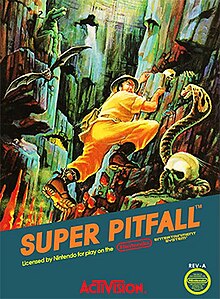Super Pitfall: Difference between revisions
m fix/remove deprecated parameter issue using AWB (11428) |
SuperPacMan (talk | contribs) m Corrected release date |
||
| Line 8: | Line 8: | ||
|designer = |
|designer = |
||
|engine = |
|engine = |
||
|released = {{vgrelease|JP=September |
|released = {{vgrelease|JP=September 5, 1986|NA=1987}} |
||
|genre = [[Platform game|Platformer]] |
|genre = [[Platform game|Platformer]] |
||
|modes= [[Single-player video game|Single-player]] |
|modes= [[Single-player video game|Single-player]] |
||
Revision as of 12:51, 5 September 2015
This article needs additional citations for verification. (July 2008) |
| Super Pitfall | |
|---|---|
 North American boxart | |
| Developer(s) | Micronics |
| Publisher(s) | Pony Inc., Activision |
| Platform(s) | PC-8801, Nintendo Entertainment System, TRS-80 Color Computer 3 |
| Genre(s) | Platformer |
| Mode(s) | Single-player |
Super Pitfall (スーパーピットフォール, Sūpā Pittofōru) is a 1986 Japanese video game for the Famicom and PC-8801 by Pony Inc. It was released for the Famicom as platformer with scrolling in September 1986. Two months later, the PC8801 version was released with switching screens. The game was released in the US in 1987 by Activision for the Nintendo Entertainment System.
It was the first game ever that Activision published for a console made by Nintendo and it was based upon Activision's earlier Pitfall! series for the Atari 2600. The game was later silently re-released without the "Rev-A" title by video-game publisher FCI. This game was also ported to the TRS-80 Color Computer 3. A sequel titled Super Pitfall II was planned, but then was cancelled a short time later. It was going to be the localized version of Sunsoft's Famicom title, Atlantis no Nazo.
Gameplay

Super Pitfall is a loose remake of Pitfall II: Lost Caverns, in that the object is to move Harry through the mazes to find the Raj diamond, and rescue his niece Rhonda and sidekick Quickclaw, both of whom have become lost in the caverns. However, Pitfall Harry's quest becomes tougher when he sees that the faithful Quickclaw is imprisoned in a cage and a key must be found, and that when Pitfall Harry finds his niece Rhonda, she has been turned to stone and he must locate a magic potion that will turn her back into a little girl. In Super Pitfall, however, Harry must also return to his starting point after accomplishing these objectives. Like the original Pitfall, but unlike Pitfall II: Lost Caverns, Harry has a limited number of lives. This time, Harry is also equipped with a gun with which he can shoot the various deadly creatures that inhabit the caverns. He has limited ammunition and must find additional bullets that are scattered. Arguably the toughest enemies are three cavemen which require more than one bullet to eliminate. Gathering gold bars results in extra points. Completion of this game requires the memorization (or mapping) of numerous hidden keys and warp zones and revealing each secret requires a precise jump, so the exploration portion of the game is very difficult.
Reception
The NES version was negatively received. A review in Computer Gaming World derided the game as "a [Super Mario Bros.] rehash that most NES users will be able to play in their sleep. Certainly, there is nothing in the game itself to keep them awake." Further complaints were directed at the lack of any credit given to David Crane, the original designer of Pitfall.[1] Brett Alan Weiss of the game database Allgame gave the game a rating of one star out of five, stating that "Pitfall is one of the best Atari 2600 games; Super Pitfall is one of the worst NES games".[2]
Gamasutra criticized it for being "vague to the point of infuriating" and "a pure trial-and-error expedition of the underground", but noted that it had some early sandbox elements and could have been better if it had "a loose goal that couples true exploration with graphics and physics that are actually good" like its contemporary, Metroid, and the present-day indie game Cave Story.[3]
The Tandy Color Computer 3 version, however, eliminated most of the glitches, included flashing notations as to where the hidden items were, and removed the requirement of having to return to the start point. This version was pointed to [by whom?] as the best of the Super Pitfall versions released. [citation needed]
References
- ^ Kunkell, Bill (August 1988). "Video Gaming World". Computer Gaming World. pp. 44–45.
- ^ Weiss, Brett Alan. "Super Pitfall - Review - allgame". Allgame. Retrieved August 23, 2009.
- ^ Gems In The Rough: Yesterday's Concepts Mined For Today, Gamasutra
